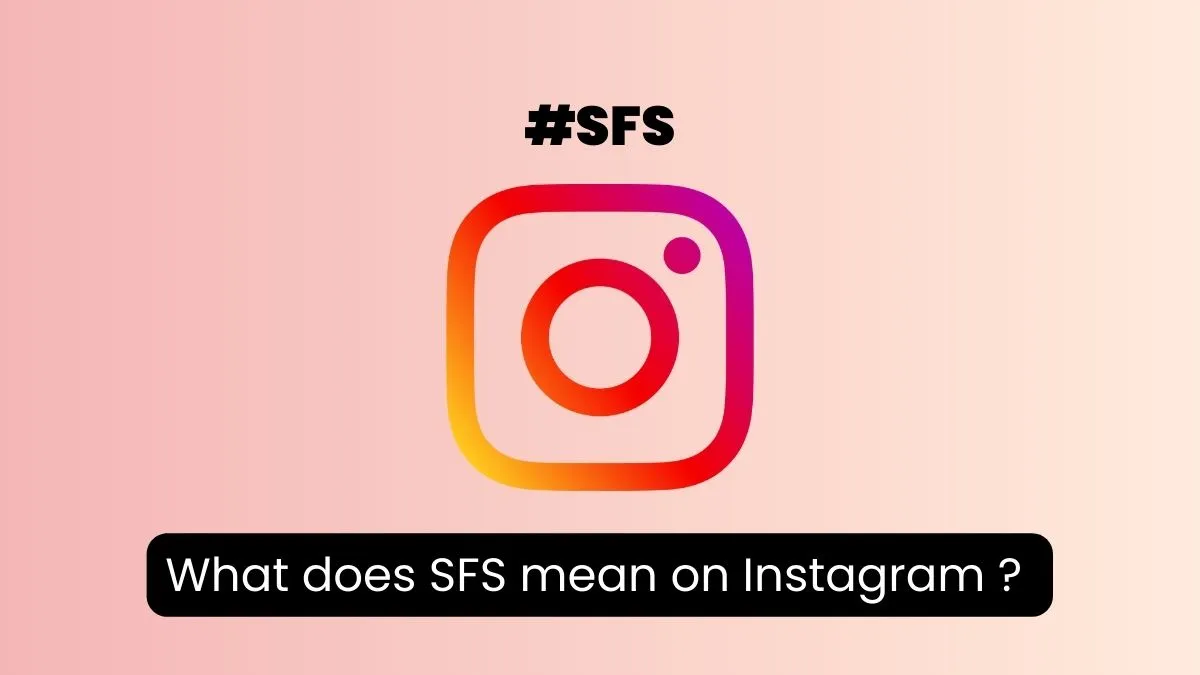Introduction
As you navigate the vast world of social media, you may come across various abbreviations and acronyms that leave you feeling puzzled. One such abbreviation, frequently encountered on Instagram, is SFS. It has become a popular trend among Instagram users, but what exactly does SFS mean?
SFS stands for “Shoutout for Shoutout,” a prevalent practice on Instagram where users promote each other’s accounts by sharing a shoutout post. Shoutouts can range from showcasing another user’s profile, highlighting their content, or recommending their account to one’s followers.
The concept behind SFS is simple: by shouting out other users, you help to expand their reach and gain exposure in return. It’s a mutual agreement where both parties benefit from increased visibility and the chance to gain new followers.
Now that we’ve unraveled the meaning behind SFS, let’s delve into how it is used on Instagram and explore its advantages and drawbacks.
What is SFS?
SFS, short for “Shoutout for Shoutout,” is a popular practice on Instagram where users collaborate to promote each other’s accounts. It is a way for Instagrammers to help one another gain more visibility and potentially increase their follower count.
When engaging in an SFS, one user will create a post or story featuring another user’s content or account. This post acts as a shoutout, recommending the featured user to the creator’s followers. In return, the featured user will reciprocate by creating a post or story that promotes the original user’s account.
The nature of SFS allows users to cross-promote each other and reach audiences they may not have otherwise connected with. It can be particularly beneficial for smaller or newer accounts looking to grow their following.
SFS is usually arranged through mutual agreements between Instagram users. They may reach out to each other via direct messages or comments to propose an SFS collaboration. Alternatively, users may also participate in SFS threads or utilize dedicated hashtags to find potential collaborators.
Overall, SFS is a strategic way for Instagram users to expand their network, increase their visibility, and potentially gain new followers. However, it is essential to be mindful of certain considerations and limitations when participating in SFS, as we will discuss in the following sections.
How is SFS used in Instagram?
Instagram users have found creative ways to incorporate SFS into their content and engage with fellow users. Here are some common methods of using SFS on the platform:
- Shoutout posts: Users can create a dedicated post featuring another user’s content or account. This may include showcasing their photos, highlighting their achievements, or endorsing their products or services. The post will typically include a caption with a shoutout message, mentioning the featured user and encouraging followers to check out their account.
- Shoutout stories: Stories are another popular way to participate in SFS. Users can create a story featuring another user’s content or profile and add text or stickers to promote them. Stories have a shorter lifespan compared to posts and can grab immediate attention.
- SFS threads and groups: Users may join SFS threads or groups within Instagram communities or engage in SFS collaborations on platforms like Discord or Telegram. These threads allow users to connect with others who are interested in SFS and arrange shoutout exchanges.
- Hashtag usage: Users utilize specific hashtags like #SFS, #shoutoutforshoutout, or variations of these to signal their interest in participating in or searching for SFS opportunities. By including relevant hashtags in their posts or stories, users increase their chances of being discovered by others looking for SFS collaborations.
It’s important for Instagram users to be authentic and genuine when participating in SFS. Simply sharing posts or stories without any meaningful engagement can diminish the effectiveness of the practice. Building relationships and engaging with the featured user’s content can strengthen the impact of an SFS collaboration.
Furthermore, it’s crucial to establish clear guidelines and expectations when arranging an SFS. This helps ensure a fair exchange and maintains transparency between participating users.
Now that we’ve explored how SFS is used in Instagram, let’s discuss the benefits and potential drawbacks of this practice.
Benefits of SFS
SFS offers a range of benefits for Instagram users who engage in this collaborative practice. Here are some of the key advantages:
- Increased visibility: SFS allows users to tap into new audiences and expand their reach. By featuring another user’s content or account, you expose yourself to their followers who may have similar interests and could potentially follow you as well.
- Networking opportunities: Participating in SFS opens the door to building connections with other Instagram users. Collaborating with like-minded individuals can lead to new collaborations, partnerships, and opportunities for growth.
- Community engagement: SFS encourages active engagement within Instagram communities. By supporting and promoting fellow users, you foster a sense of community and reciprocity, creating a positive and supportive environment.
- Discovering new content: Through SFS, you have the chance to explore and appreciate different types of content that may not have crossed your path otherwise. This can introduce you to new perspectives, styles, and ideas in your niche or area of interest.
- Boosting follower count: SFS can lead to an increase in followers, especially for smaller or newer accounts. By leveraging the reach and influence of other users, you have the opportunity to attract a broader audience and grow your community.
While these benefits make SFS an attractive strategy for many Instagram users, it’s important to consider the potential drawbacks as well. Let’s examine some of the limitations of SFS in the next section.
Drawbacks of SFS
While SFS can be a valuable tool for expanding your Instagram presence, it’s essential to be aware of the potential drawbacks associated with this practice. Here are some of the limitations of SFS:
- Inauthentic engagement: Sometimes, the focus of SFS can shift solely towards gaining followers rather than fostering meaningful engagement. This can result in users following accounts only for the sake of reciprocating shoutouts, leading to a superficial level of interaction.
- Follower quality: When participating in SFS, there’s no guarantee that the followers gained will be highly engaged or genuinely interested in your content. The emphasis is often on quantity rather than quality, which may not lead to long-term engagement or conversions.
- Limited target audience: While SFS can expose you to new audiences, the overlap between your followers and the featured user’s followers may already be significant. This repetition may limit your reach to a diverse range of potential followers.
- Time investment: Engaging in SFS collaborations requires time and effort. Searching for potential partners, negotiating agreements, and creating shoutout content can be time-consuming, potentially taking away from other activities or strategies to grow your account.
- Dependency on partnerships: Relying solely on SFS for account growth can create a dependence on collaborations with other users. If those partnerships become less frequent or cease altogether, it can impact your visibility and hinder your growth strategy.
Understanding these drawbacks can help you approach SFS collaborations with a realistic mindset. It’s important to strike a balance and utilize SFS in conjunction with other strategies to maximize the benefits and mitigate the limitations.
Now that we have explored the benefits and drawbacks of SFS, let’s delve into the steps involved in participating in an SFS on Instagram.
How to participate in SFS?
If you’re interested in participating in SFS to expand your Instagram presence, here are some steps to get started:
- Identify potential partners: Look for Instagram accounts in your niche or with similar interests that you admire and would like to collaborate with. This can be done through hashtags, explore pages, or engaging in relevant communities.
- Reach out and propose an SFS: Once you’ve identified potential partners, send them a direct message or leave a comment expressing your interest in collaborating on an SFS. Be friendly, genuine, and make sure to clearly communicate the details of the collaboration.
- Negotiate the terms: Discuss and agree upon the specifics of the shoutout, including the content or account to be featured, the date and time of the shoutout, and any additional details you both find relevant.
- Create and share the shoutout post: Design a visually appealing post or story that showcases the featured user. Write a compelling caption introducing them and encouraging your followers to check out their content or account.
- Reciprocate the shoutout: Once the featured user has shared your shoutout, it’s essential to reciprocate the gesture. Create a post or story highlighting their content or account, and make sure to mention and tag them to direct your followers to their profile.
- Engage with their audience: In addition to sharing the shoutout, take the time to engage with the featured user’s content and interact with their followers. This shows authenticity and can help foster meaningful connections.
- Track and analyze the results: Monitor the impact of the shoutout by keeping an eye on your follower count, engagement metrics, and any other key performance indicators. This will help you assess the effectiveness of the SFS and determine its value for future collaborations.
Remember, successful SFS collaborations are built on mutual support, transparency, and genuine interest in each other’s content. By participating in SFS, you can establish valuable connections, expand your reach, and potentially attract new followers.
Now, let’s uncover some tips to create engaging and impactful SFS posts for maximum effectiveness.
Tips for successful SFS posts
Creating compelling and impactful SFS posts is key to maximizing the effectiveness of your collaborations. Here are some tips to help you create successful SFS posts:
- Be selective with your partners: Choose accounts that align with your content, values, and target audience. This will ensure a more relevant shoutout and increase the chances of attracting engaged followers.
- Showcase the featured user creatively: Design visually appealing posts or stories that highlight the featured user’s content or account. Use eye-catching images, videos, or graphics to make your shoutout stand out in the crowded Instagram feed.
- Create captivating captions: Craft compelling captions that introduce the featured user and provide a genuine recommendation. Share why you admire their content and encourage your followers to check them out.
- Use relevant hashtags: Include relevant hashtags in your shoutout to increase its discoverability. Research popular hashtags in your niche to target the right audience and attract potential followers.
- Tag the featured user: Make sure to tag the featured user in your post or story, allowing your followers to easily navigate to their profile. Tagging also notifies the featured user, increasing the likelihood of them reciprocating the shoutout.
- Engage with the featured user’s audience: After sharing the shoutout, take the time to engage with the comments and questions from the featured user’s followers. This demonstrates your authenticity and fosters connections with potential new followers.
- Follow up and express gratitude: Send a message of appreciation to the featured user after the SFS collaboration. Express your gratitude for their support and maintain a positive rapport for future collaborations.
- Track and analyze the results: Keep track of the performance metrics of your SFS posts, such as follower growth, engagement, and reach. Analyzing these results will help you refine your SFS strategy and improve future collaborations.
Remember that while SFS can be a valuable strategy, it’s important to incorporate it alongside other growth strategies on Instagram. Building genuine relationships, creating high-quality content, and engaging with your audience on a consistent basis will contribute to long-term success.
Now that we’ve explored the tips for successful SFS posts, let’s wrap up our discussion on SFS.
Conclusion
In the vast and ever-evolving world of Instagram, SFS, or Shoutout for Shoutout, has emerged as a popular practice among users. By collaborating and promoting each other’s accounts, users can expand their reach, increase visibility, and potentially gain new followers.
SFS allows users to engage in cross-promotion, where one user creates a shoutout post or story featuring another user’s content or account. This mutual agreement helps both parties to grow their follower count and tap into new audiences.
While SFS offers several benefits, it’s essential to consider the potential drawbacks associated with the practice. These include inauthentic engagement, limited target audience reach, and the time investment required for collaborations.
To participate in SFS, users need to identify potential partners, reach out and propose an SFS, negotiate the terms, create and share the shoutout post, reciprocate the shoutout, engage with the featured user’s audience, and track and analyze the results.
When creating SFS posts, it’s important to be selective with partners, showcase the featured user creatively, use captivating captions, include relevant hashtags, tag the featured user, engage with their audience, and express gratitude.
Understanding the nuances and best practices of SFS can help Instagram users harness its potential and leverage it as a growth strategy. However, it’s crucial to remember that SFS should be used in conjunction with other strategies to maintain a well-rounded and authentic account growth approach.
So, whether you’re a seasoned Instagram user or just starting your journey, consider exploring the world of SFS and see how it can help you connect with like-minded individuals, expand your network, and gain visibility on the platform.

























